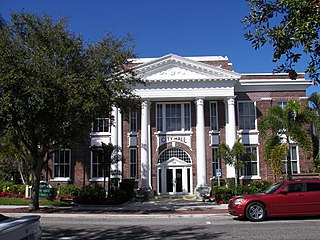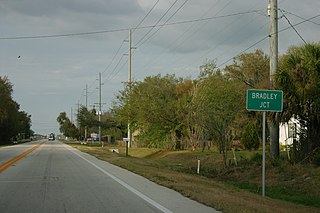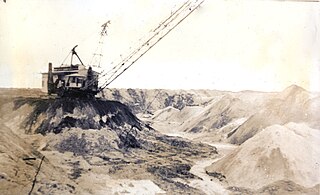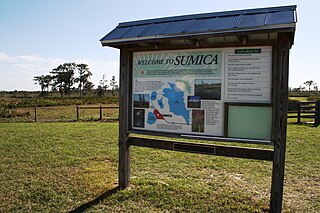Liverpool | |
|---|---|
| Country | |
| State | |
| County | De Soto County, Florida |
| Founded | 1880 |
Liverpool is a ghost town in DeSoto County, Florida, United States on the Peace River.
Liverpool | |
|---|---|
| Country | |
| State | |
| County | De Soto County, Florida |
| Founded | 1880 |
Liverpool is a ghost town in DeSoto County, Florida, United States on the Peace River.
Liverpool was a phosphate mining town in Florida and was named for its founder, John Cross, from Liverpool, England. Liverpool was most likely chosen because it was on the Peace River, which provided a way that mined phosphate could be transported to Charlotte Harbor. A second reason why it was chosen because it was at the Peace River Mining Company Railroad's southernmost tip and could be shipped down the river with barges. The town was founded in 1880 and was platted, after phosphate had been discovered in the region. Its founder had envisioned the town being a major center of commerce. He operated the town's general store and J. E. Riley oversaw the town's mining operations, served as its mayor and served as a local sheriff. The town in its heyday had docks along the river, post office, hotel, newspaper and a stage shop. After this, John Cross decided to buy and develop land in Charlotte County. The town's postal service was discontinued in 1895, in the same year a map was made of Charlotte County and showed the town on the Peace River. In 1905, the area started to run out of phosphate and the town began to decline. The railroad was soon extended further south to Punta Gorda and Boca Grande, making its decline much faster and commerce was starting to shift to Fort Ogden and by the 1920s it was completely gone. [1] [2] [3]

DeSoto County is a county located in the Florida Heartland region of the U.S. state of Florida. As of the 2020 census, the population was 33,976. Its county seat is Arcadia.

Hardee County is a county located in the Florida Heartland of the Central Florida region in the U.S. state of Florida. As of the 2020 census, the population was 25,327. Its county seat is Wauchula.

Arcadia is a city and county seat of DeSoto County, Florida, United States. Arcadia's Historic District is listed on the National Register of Historic Places. Its population was 7,420 as of the 2020 census, down from 7,637 at the 2010 census. It is the principal city of the Arcadia, Florida Micropolitan Statistical Area.

Mulberry is a city in Polk County, Florida, United States. It is part of the Lakeland–Winter Haven Metropolitan Statistical Area, with parts of unincorporated Lakeland on its northern boundary. The population was 3,952 at the 2020 census. Mulberry is home to the 334-acre Alafia River Reserve, and it is the headquarters to Badcock Home Furniture.

Brewster is a ghost town in southwest Polk County, Florida, United States, ten miles south of Mulberry. It is at an elevation of 143 feet above sea level and has been uninhabited since the early 1960s. The population is 3, according to the 2010 Census.

Hamburg is a ghost town in Aiken County, South Carolina, United States. It was once a thriving upriver market located across the Savannah River from Augusta, Georgia in the Edgefield District. It was founded by Henry Shultz in 1821 who named it after his home town in Germany of the same name. The town was one of the state's primary interior markets by the 1830s, due largely to the fact that the South Carolina Canal and Rail Road Company chose Hamburg as the western terminus of its line to Charleston.
Boca Grande is a small residential community on Gasparilla Island in southwest Florida. Gasparilla Island is a part of both Charlotte and Lee counties, while the actual village of Boca Grande, which is home to many seasonal and some year-round residents, is entirely in the Lee County portion of the island. It is part of the Cape Coral-Fort Myers, Florida Metropolitan Statistical Area. Boca Grande is known for its historic downtown, sugar sand beaches, blue water and world class fishing.

The Bone Valley is a region of central Florida, encompassing portions of present-day Hardee, Hillsborough, Manatee, and Polk counties, in which phosphate is mined for use in the production of agricultural fertilizer. Florida currently contains the largest known deposits of phosphate in the United States.

Pine Level is a ghost town in DeSoto County, Florida, United States.

The Florida Heartland is a region of Florida located to the north and west of Lake Okeechobee, composed of six inland, non-metropolitan counties—DeSoto, Glades, Hardee, Hendry, Highlands, and Okeechobee. In 2000, The US Census Bureau recorded the population of the region at 229,509. In 2010, The US Census Bureau recorded the population of the region at 253,399, a growth rate of 11.0%. The most populous county in the region is Highlands County, and the region's largest cities are Avon Park and Sebring, both with slightly more than 10,000 people. Unlike the coastal areas to the east and west, the rural nature of the Florida Heartland is culturally closer to the Deep South than the rest of South Florida and has traditionally been inhabited by Americans of predominantly English ancestry. While located in Palm Beach County, the nearby rural cities of South Bay, Belle Glade and Pahokee as well as the census-designated place of Lake Harbor, located on the southeastern shore of Lake Okeechobee, are more associated with the Florida Heartland than the remainder of South Florida. The same could also apply to the Collier County communities of Immokalee, Ave Maria and Harker as well as to the Martin County community of Port Mayaca. Occasionally included are the southern Polk County communities of Fort Meade, Frostproof and River Ranch as well as Yeehaw Junction in Osceola County.
The Florida Southern Railway was a railroad that operated in Florida in the late 1800s. It was one of Florida's three notable narrow gauge railway when it was built along with the South Florida Railroad and the Orange Belt Railway. The Florida Southern was originally chartered to run from Lake City south through central Florida to Charlotte Harbor. However, with the influence of Henry B. Plant, it operated with two discontinuous segments that would be part of the Plant System, which would later become part of the Atlantic Coast Line Railroad.

Punta Gorda is a city located in Southwest Florida and is the county seat of Charlotte County, Florida, United States. As of the 2020 U.S. Census the city had a population of 19,471, up from 16,641 at the 2010 census. Punta Gorda is the principal city of the Punta Gorda, Florida Metropolitan Statistical Area, part of the North Port-Bradenton Florida Combined Statistical Area.

Bradley Junction is an unincorporated community and census-designated place in southwestern Polk County, Florida, United States. Its population was 542 as of the 2020 census.
The Charlotte Harbor and Northern Railway is a historic railroad line that at its greatest extent serviced Gasparilla Island in Charlotte Harbor and a major shipping port that once operated there. The railroad's principal purpose was to transport phosphate mined along the Peace River and in the Bone Valley region of Central Florida to the port to be shipped. It also brought passengers to the island community of Boca Grande on Gasparilla Island, and is largely responsible for making Boca Grande the popular tourist destination it is today. Part of the line remains in service today between Mulberry and Arcadia, which is now owned and operated by CSX Transportation. Today, it makes up CSX's Achan Subdivision and part of their Brewster Subdivision.
The Brewster Subdivision is a railroad line owned by CSX Transportation in Florida. The line runs from the Valrico Subdivision at Edison Junction south through Bradley Junction to Arcadia for a total of 47.2 miles. It junctions with the Achan Subdivision and the Agricola Spur at Bradley Junction, and connects to the Seminole Gulf Railway in Arcadia.

Agricola is a former company town in Polk County, Florida, United States that was built in 1907, 15 kilometres (9.3 mi) south-west of Bartow. It is at a mean elevation of 167 feet. The town was built to house employees of food processing business Swift and Company. The town operated a food processing plant and a phosphate mining operation until the 1950s. Residents were exclusively factory workers and their families. The community was self contained and self reliable with shops, schools and houses for the workers and their families. The town lasted up until the 1950s, when the expansion of the phosphate industry ended the need for providing housing for employees. The town residents were offered a decision to purchase and move their homes. Whatever was not moved was destroyed. After the town was destroyed, the area operated as a phosphate mine.
Pemberton Ferry, later renamed Croom, is a ghost town in Central Florida near Brooksville, Florida, and Ridge Manor, Florida. A rail line came to Pemberton Ferry in 1884. It was a rail stop by the Withlacoochee River just north of where the I-75 bridge over Croom-Rital Road and Withlacoochee State Trail is today.
Moffitt is a ghost town in Hardee County, Florida, United States.

Ellaville, Florida is a ghost town in Florida located in the Suwannee River State Park in Suwannee County, Florida, United States. Ellaville was located at the merging place of the Suwannee River and Withlacoochee River.

Sumica, alternatively written as SUMICA, was a mill town in Polk County, Florida, United States. The ghost town is commemorated by a historical marker off S.R. 60. There is also a Southwest Florida Water Management District preserve in the area named for the former logging settlement and mill town. Goods from a company store in the town could be purchased with company issued currency, including 25 cent and 5 cent scrip.
27°02′38″N81°59′06″W / 27.044°N 81.985°W